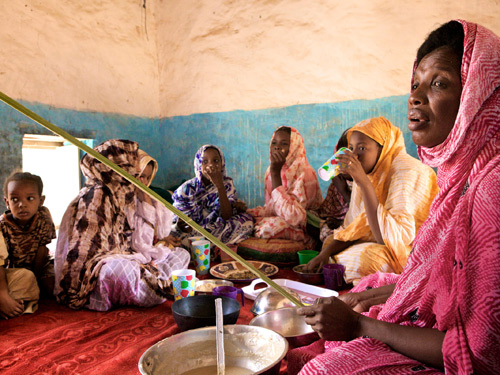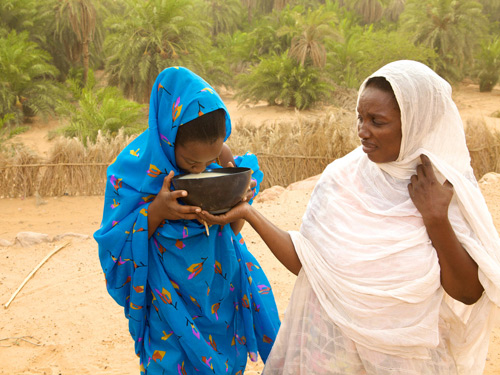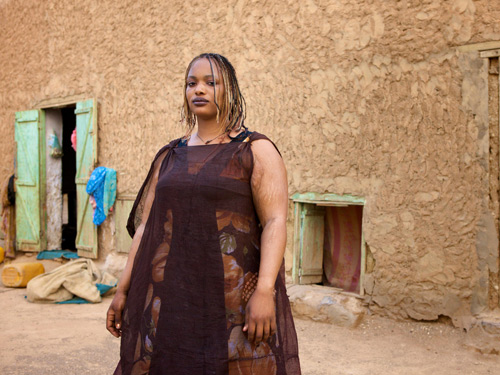In Mauritania, where big is beautiful and stretch marks are sexy, young girls are brutally force-fed a diet of up to 16,000 calories a day — more than four times that of a male bodybuilder — to prepare them for marriage.
It sounded like summer camp. “You’re going on vacation to the desert to meet other girls and eat sweet food,” Tijanniya Mint Tijani’s mother told her. Tijanniya was excited. “She said that by the time I returned home, I’d be a beautiful woman.”
Ten days later, Tijanniya, 14, a sporty student from the town of Atar in the West African country of Mauritania, is eating breakfast with five other girls, ages 7 to 12, in a cramped sandstone hut deep in the Sahara Desert. Her stomach is already bloated from huge quantities of goat’s milk and oily couscous, but the meal is not over. The next course is a pint of pounded millet mixed with water. Tijanniya chokes down the thick gruel — she has no choice. An older woman dressed in pink robes threatens to beat her with a long cane if she refuses. Worse, if she throws up, the woman will make her eat her own vomit. Outside, a strong wind whips sand into strange, phantasmagoric shapes. The girls have been sent to this desolate spot near Atar to endure the practice of leblouh — intensive force-feeding. “The aim is to feed them until their bodies blow up like balloons,” says Aminetou Mint Elhacen, 50, the woman wielding the cane.
The ideal of feminine beauty in Mauritania, a country one-and-a-half times the size of Texas and blanketed in desert, is like America’s cult of superthinness in reverse. Mauritanian tradition holds that among women, rolling layers of fat are the height of sexiness. The preference originated centuries ago among the Moors, nomadic Muslims of Arabic and Berber stock who make up two-thirds of Mauritania’s 3.1 million people. To the ancient Moors, a fat wife (much like fat livestock) was a symbol of a man’s wealth, proof that he had enough riches to feed her generously while others perished in the drought-prone terrain.
Until recently, it appeared that force-feeding and the big-is-beautiful ethos were dying out. Although leblouh has never been outlawed in this Islamic republic, in 2003 the government started a campaign to fight child abuse and raise awareness of the health risks of obesity. Moreover, as diverse global influences — from knockoff Western fashions to Nigerian pop music and French TV — slowly reached the masses, young women in cities like Nouakchott, the capital, were beginning to slim down under theirmulafa robes. But in December 2007, progress stalled when gunmen with suspected ties to al Qaeda’s North African wing murdered four French vacationers near the capital, causing tourism and foreign investment to plummet. Then, in August 2008, a military coup removed the democratic government and installed a junta that favored “a return to tradition.” An election in July kept the junta in power, despite claims of massive vote-rigging.
Now big women are back in vogue, and the custom of funneling rich food into young girls like geese farmed for foie gras is once again thriving unchecked. Elhacen, a droopy-eyed professional force-feeder, estimates that around Atar, a commercial hub 250 miles from Nouakchott, the proportion of girls undergoing force-feeding has climbed to over 80 percent. Government figures from before the 2008 coup put the rate at 50 to 60 percent in rural areas and 20 to 30 percent in cities. “The practice is re-emerging because men still find mounds of female flesh comforting and erotic,” explains Seyid Ould Seyid, a Mauritanian male journalist. “The attraction is ingrained from birth.”
Elhacen, who makes the equivalent of $155 for each girl she force-feeds over a three-month period, is delighted. “I have a lot more clients again,” she notes. Her current “clients” are lying down in the hut in glassy-eyed exhaustion, digesting breakfast. Elhacen mixes crushed dates and peanuts with couscous and oil to make the second of the day’s four meals — cloying, egg-size balls of around 300 calories apiece. Each girl eats about 40 per day, along with 12 pints of goat’s milk and gruel, making their daily intake 14,000 to 16,000 calories. The recommended consumption for a healthy 12-year-old girl averages 1500 calories; an adult male bodybuilder eats up to 4000.
“My stomach hurts,” groans Tijanniya. The daughter of livestock dealers, she’s furious with her parents for sending her here. “I don’t want to be fat. I don’t think it’s beautiful. Now I see why some girls at school came back fat after vacation, but they were much prettier before.” Tijanniya adjusts her electric-blue mulafa, revealing a yellow T-shirt and trendy denim skirt underneath. “I love sports. I’m scared I won’t be able to run fast when I’m fat.”
 How do small girls eat these gargantuan amounts of food? “I’m very strict,” boasts Elhacen. “I beat the girls, or torture them by squeezing a stick between their toes. I isolate them and tell them that thin women are inferior.” Desert settlements like this 1000-strong farming community with no electricity or running water are popular spots for leblouh because there are no distractions and no easy ways to escape. But Elhacen denies that her work amounts to child cruelty. “No, no, it’s for their own good,” she almost shrieks. “How will these poor girls find a husband if they’re bony and revolting?”
How do small girls eat these gargantuan amounts of food? “I’m very strict,” boasts Elhacen. “I beat the girls, or torture them by squeezing a stick between their toes. I isolate them and tell them that thin women are inferior.” Desert settlements like this 1000-strong farming community with no electricity or running water are popular spots for leblouh because there are no distractions and no easy ways to escape. But Elhacen denies that her work amounts to child cruelty. “No, no, it’s for their own good,” she almost shrieks. “How will these poor girls find a husband if they’re bony and revolting?”
A real concern, as leblouh is linked to another abominable practice: child marriage. Most girls wed between the ages of 12 and 14. “Increasing a girl’s size creates the illusion that she’s physically mature, that she’s ready for a husband,” notes Aminetou Moctar, a feisty, pencil-thin woman in her 50s who is chief of the Association of Women Heads of Households, an equal-rights organization in Nouakchott. “But force-feeding grows the body and shrinks the brain — all the girls do is eat and sleep.”
Tijanniya wants to become a French teacher, but Elhacen says her parents have already arranged a marriage for her. “Her job will be to make babies and be a soft, fleshy bed for her husband to lie on.” To this end, she intends to fast-track Tijanniya’s weight gain by serving her cups of pure animal fat. “The stomach flab should cascade, the thighs should overlap, and the neck should have thick ripples of fat,” says Elhacen. The ultimate sign of beauty, however, is silvery stretch marks on the arms. “Parents will give me a bonus if a girl develops stretch marks.”
Back in Atar, a collection of narrow, sandy lanes and cubbyhole shops, 26-year-old Zeinebou Mint Mohamed offers a glimpse into the girls’ potential future. A grocery-store owner who is 5’4″ and over 200 pounds, with her braided hair dyed blonde at the tips and stretch marks on her arms, she’s a modern woman who has a love-hate relationship with her size.
“I was force-fed as a child. I vomited and suffered heartburn and diarrhea, but I gained weight fast,” Zeinebou recalls, reclining in her ramshackle two-room home. At 13, she was married to a much older man, and by 16 she had two sons. Then, like any normal teen, she rebelled, prompting her husband to divorce her. Newly single, she was flooded with romantic offers. “I suddenly saw how much Mauritanian men adore very fat women. Men told me I had the most beautiful body in town, and they fought over me.” With her huge eyes and charismatic smile, Zeinebou would be a great beauty whatever her size. But the male reaction to her figure transformed her self-image. “When I realized the power I had over men, I started to enjoy being fat.” Zeinebou’s current boyfriend, Baba Slama, 29, who is, like many Mauritanian men, rail-thin, agrees that she’s in charge. “She’s gorgeous; I love her,” he says.
Yet Zeinebou’s weight slows her down: “I’m always tired, and I wheeze when I walk. I want to be slimmer so I can be more dynamic.” A fan of TV soaps beamed in from France and Morocco, she confesses she’s drawn to the lifestyles of the female stars. “They seem so independent,” she says. “I’d love to be able to wear jeans and high heels. I want to diet, but I’m scared men won’t like me anymore.”
 Zeinebou also frets that she would lose her It-girl status among her female friends. “My first thought when I met Zeinebou was, Where did she get that incredible body?” says her best friend, Hawer Sessay, 26. “I was so jealous.” Although hardly skeletal at 5’6″ and 180 pounds, Hawer says she has trouble piling on weight, and was teased by plumper girls as a teenager. Recently, her husband told her that he “didn’t like sleeping with a bag of bones.” Desperate to be bigger, Hawer uses drugs to aid weight gain. She produces a bottle of pills whose active ingredient is cyproheptadine hydrochloride, an allergy medication with a side effect of increased appetite. Misused, the drug can cause low blood pressure, blurred vision, kidney failure, and other problems. “I bought this one because the pharmacist told me it was the least dangerous.”
Zeinebou also frets that she would lose her It-girl status among her female friends. “My first thought when I met Zeinebou was, Where did she get that incredible body?” says her best friend, Hawer Sessay, 26. “I was so jealous.” Although hardly skeletal at 5’6″ and 180 pounds, Hawer says she has trouble piling on weight, and was teased by plumper girls as a teenager. Recently, her husband told her that he “didn’t like sleeping with a bag of bones.” Desperate to be bigger, Hawer uses drugs to aid weight gain. She produces a bottle of pills whose active ingredient is cyproheptadine hydrochloride, an allergy medication with a side effect of increased appetite. Misused, the drug can cause low blood pressure, blurred vision, kidney failure, and other problems. “I bought this one because the pharmacist told me it was the least dangerous.”
Aminetou, the anti-force-feeding activist, says that pharmaceuticals are “the new form of leblouh.” Sold secretly at city markets, they include hormones used to fatten camels and chickens, and steroids for asthma and cancer that cause bloating. A neighbor of Aminetou’s died in May after taking animal hormones while pregnant. “She hoped it would give her a fat baby,” sighs the activist.
Aminetou has petitioned the junta to take action, to no avail. “The authorities want women to return to their traditional roles — cooking, staying indoors, and staying fat to keep men happy,” she says. A government spokesperson, Mbarke Mint Mohamed, denies that the authorities condone leblouh or female obesity. “We take these problems very seriously,” she says, but can’t name any measures introduced to address them since the 2008 coup. Meanwhile, Dr. Mohammed Ould Madene, an emergency medicine specialist in dusty downtown Nouakchott, says the fat ideal is “a grave matter of public health.” He’s alarmed by the number of patients he sees with diabetes, hypertension, heart disease, and depression. He mentions the recent case of a girl who was rushed to the clinic unconscious. “She was only 14, but so huge that her heart had almost collapsed under the strain.”
Yet some young women in the capital refuse to bulk up. “I’ve always been thin, and I love my size,” says Aminetou Kane, 28, a bright-eyed social worker. “I can work, I can dance, I can walk three miles to the beach.” Many of her girlfriends, educated career women like herself, prefer to be slimmer, too, she adds. Another encouraging sign is the success of Nouakchott’s first women-only gym, where around 300 women exchange their mulafa robes for sweats. “The membership is still tiny, but I’m hoping it will expand,” says the owner, Zahoura Kajouane. “Some women join on doctor’s orders, but others are image-conscious. One woman hopes to be the Shakira of Mauritania.”
That said, women here will almost certainly never strive to be a skinny size 0. In Zeinebou’s home, she and Hawer inspect a photo of a bikini-clad model in a glossy magazine from neighboring Morocco. The svelte woman has — to Western eyes — a perfect figure, but the two women are genuinely repelled. “She looks ill,” they agree, clicking their tongues at her jutting hips and clavicles. Then they turn to an article about liposuction, and laugh so hard the walls seem to shake.
Written by ABIGAIL HAWORTH of Marie Claire
Credits: The Earth Child.










Sad